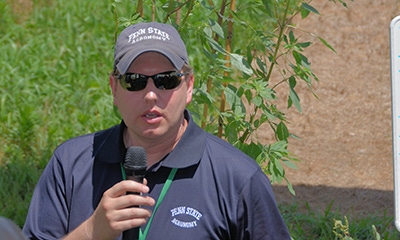May 2, 2016

Researchers and extension specialists in Penn State University's College of Agricultural Sciences are warning growers to be on the lookout for Palmer amaranth and waterhemp, two species of pigweed that are gaining footholds in Northeast fields. "Palmer amaranth is relatively new to Pennsylvania," says Dwight Lingenfelter, Extension weed specialist.

MONSTER PIG: The Palmer amaranth towering behind Lingenfelter is a sample of the size of pigweed that can quickly outcompete soybeans and corn.
"It's a common problem in the Southern cotton belt to western Kansas. It spread to the Delmarva Peninsula and much of the Midwest in the last five years." Lingenfelter speculates that the weed may have come to the Northeast in cottonseed meal for dairy rations, in other types of crop seed, with used equipment, or with shipments of hay. Locally, seeds can spread from one field to the next via combine harvest.
First detected in Pennsylvania in 2013, Palmer amaranth has been found growing in soybeans, corn and alfalfa, as well as in noncrop areas and at field edges, in at least 14 counties. Its likely present in more counties, but that has yet to be documented. Isolated populations of waterhemp, which is a serious problem in the Midwest, have been in the Northeast for several years. Both weeds also are likely to cause serious problems in vegetable and small-fruit production.
The threat?
What makes Palmer amaranth and waterhemp such a threat is their aggressive growth habit, prolific seed production and the lack of effective control measures, confirms Bill Curran, professor of weed science at Penn State. "These plants can grow 1 to 2 inches per day," he adds.
Worse, each plant can produce 300,000 or more seeds, and new plants can emerge throughout the growing season. Most will start to emerge in late April or early May. But it's not uncommon to have plants emerging into July.
And, both species have shown widespread resistance to common herbicides such as glyphosate and Group 2 or ALS-inhibitor herbicides. They also “tolerate” – meaning survive both tillage and no-till practices, adds Curran.
The worst part is that these annual weeds can significantly cut crop yields. In a Tennessee study, Palmer amaranth and waterhemp reduced soybean yields by 78% and 56%, respectively. In worst case studies, high densities of Palmer amaranth cut corn yields by up to 91%. Experts say
What to look for
Scouting and proper identification is the first line of defense. Palmer amaranth has smooth stem and leaves, with leaf petioles (the leaf stem that attaches it to the main stalk) that are longer than the blade. Leaf blades occasionally have a v-shaped, white or dark-red patch or "watermark," and a single hair sometimes can be found on the leaf tip
Flowering female plants have "prickly" flower bracts, and seed heads often are 1 to 2 feet long. Young plants can have a poinsettia-like appearance and grow to mature heights of 8 feet tall.
Waterhemp can vary in appearance. Generally, waterhemp plants have no hairs on the stem or leaves. Leaves often are glossy and more elongated than those on Palmer amaranth. Stem color of waterhemp can vary from light green to dark red, with multiple shades sometimes on the same plant.
Both weeds produce separate male and female plants. Male plant pollen travels with the wind to pollinate females. If the male plant is herbicide resistant, then female’s seeds will also have some resistance.
5 control tips
Here are a few suggestions from Lingenfelter and Curran:
* Prevent seed production and spread. "It’s preferable to eradication," contends Lingenfelter. "Do whatever it takes to not allow new infestations to set seed."
* Consider harvesting infested fields last to prevent spread via combine.
* Integrating cultural control tactics, such as including cover crops, may help to keep these weeds from establishing.
* Use multiple, effective modes of action. "Current strategies are based heavily on herbicides," notes Curran. "But the chance for increased herbicide resistance is very high." He strongly advises using a two-pass system of herbicide application for effective control. And, he warns, your annual herbicide costs will at least double if Palmer amaranth becomes established.
* Control "escapes”. Aim for complete control of Palmer amaranth – allow no escapes. Even a few plants setting seed can cause profound negative impacts.
For more on weed ID and herbicide control options, click on palmer-amaranth.
You May Also Like




